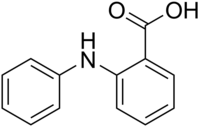Fenamic acid

| |

| |
| Names | |
|---|---|
| Preferred IUPAC name
2-Anilinobenzoic acid | |
| Other names
N-phenylanthranilic acid
| |
| Identifiers | |
3D model (
JSmol ) |
|
| ChEBI | |
| ChEMBL | |
| ChemSpider | |
ECHA InfoCard
|
100.001.879 |
IUPHAR/BPS |
|
PubChem CID
|
|
| UNII | |
CompTox Dashboard (EPA)
|
|
| |
| |
| Properties | |
| C13H11NO2 | |
| Molar mass | 213.23 g/mol |
Except where otherwise noted, data are given for materials in their standard state (at 25 °C [77 °F], 100 kPa).
| |
Fenamic acid is an organic compound, which, especially in its ester form, is called fenamate.[1]: 458 serves as a parent structure for several nonsteroidal anti-inflammatory drugs (NSAIDs), including mefenamic acid, tolfenamic acid, flufenamic acid, and meclofenamic acid. These drugs are commonly referred to as "anthranilic acid derivatives" or "fenamates" because fenamic acid is a derivative of anthranilic acid.[2]: 235 [3]: 17 [2]
Fenamic acid can be synthesized from
References
- ISBN 9780781746731
- ^ ISBN 9788131731444
- ^ Auburn University course material. Jack DeRuiter, Principles of Drug Action 2, Fall 2002 1: Non-Steroidal Antiinflammatory Drugs (NSAIDS)
- .
